Dominion
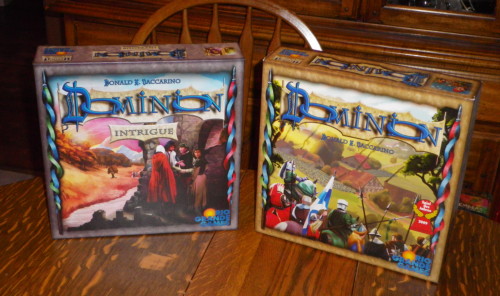
How about a nice game of Dominion?
What is it?: Dominion is a card game by Rio Grande games designed by Donald X. Vaccarino wherein the object is to be the player with the most victory points at the end of the game.
On a scale from Preschool to Post-Doc, how hard is it to play?: Officially the age listed is 13++. Can younger people play it? It can be a thinky game that involves planning and strategy so if your pre-teen can handle that, then they can play. If your Post-Doc can handle that, they can also play.
What will it cost me?: Rio Grande is officially listing Dominion (the base set) and Intrigue (the other base set) for $44.95. Amazon is running a sale pricing the base set at just over $30; if you are willing to shop around, it is possible to pick up a box for about half off. These are the only two sets that come with everything you need to play, so you could get by with just one or the other; Dominion is a quasi-collectible card game in which you do not need to have anything but one of the basic sets to play.
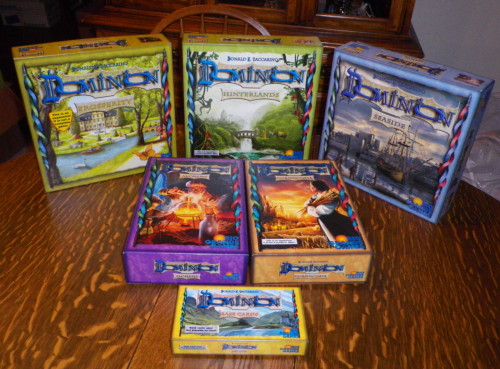
Alternately, you can pick up a pack of the base cards ($20 list, $15 on a deal – it’s the tiniest box in the pic) and one of the expansions (Cornucopia or Alchemy are the smaller ones running $30 list, $20 on a deal. Hinterlands, Seaside and Prosperity run about $40 list). Why go this route? Each expansion has a different focus to the card sets, so within each expansion the play has a slightly different feel.
Alternately, alternately – if you find the game really enjoyable and you have some spending cash, get several expansions or go whole hog and get the entire collection. You can play with any or all of the expansions at once very easily and mixing themes can be fun. Vaccarino has stated that he will design only a couple more expansions so you won’t need to shell out money annually for the rest of your life to keep up.
How many can play?: Officially two to four players. Again, the two-player game can get a little cut throat because there is only one other person to play cards on. We’ve played with more than four, but the cards probably won’t support more than six (unless you fudge the end game rules slightly).
How long does it take to play?: Officially 20-30 minutes; 30 minutes is probably the better time estimate.
What do I need to play?: Either of the base box sets (Dominion or Intrigue) OR a set of Base Cards and any of the expansions (Alchemy, Cornucopia, Hinterlands, Prosperity, or Seaside).
How do I play it?: Rio Grand has a nice downloadable PDF for Dominion, Intrigue and the expansions that tells you everything you need to know. That link will take you to just the Dominion rules; for Intrigue and the expansions, go here and click on the set name on the bottom middle of the page. The downloadable instructions for that particular set or expansion will be on the right hand side near the bottom. Unofficially (and perhaps a little more succinctly), I’ll just run through the highlights to get you going.
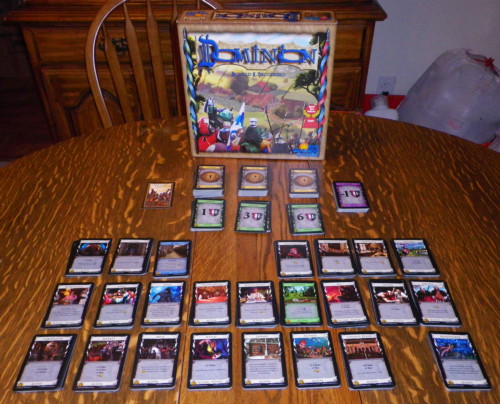
These are all the cards you will find in one of the basic sets. Both basic sets (Dominion shown above, cards from Intrigue featured below) have:
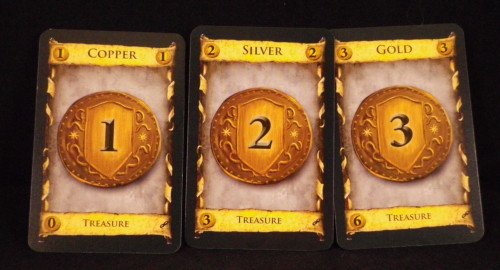
yellow Treasure cards (copper, silver, gold),
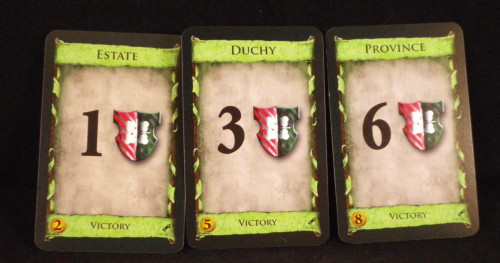
green Victory cards (Estate, Duchy, Province),
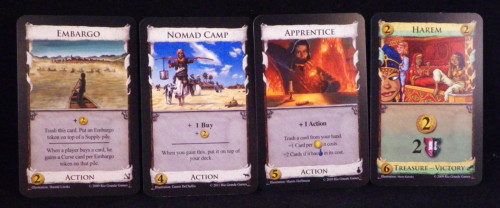
Kingdom cards (there are 25 different Kingdom cards to choose from in Dominion),

and a blue-backed set of one of every card that is not a Curse or basic Treasure or Victory card in the game.
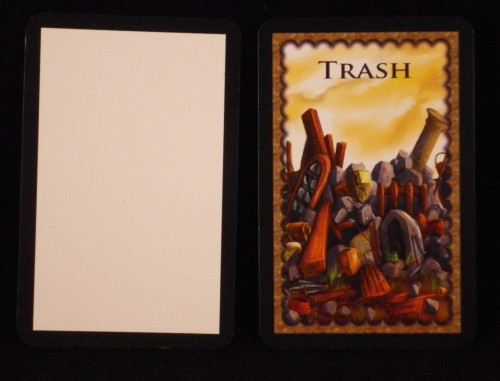
There is also a “Trash” marker card and blank white-faced cards.
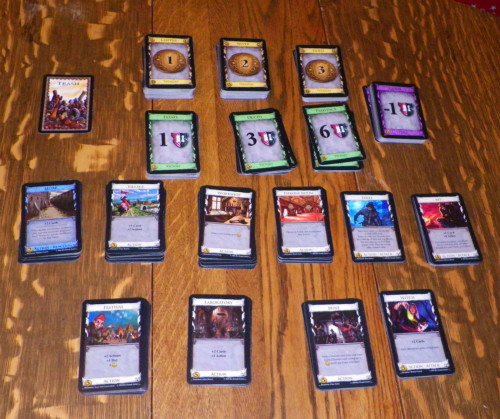
Set Up: Pull your basic treasure cards (Copper, Silver, Gold) and basic victory cards (Estate, Duchy, Province) and set them in the middle of the play area. This is the start of your Supply. Pull 10 Kingdom cards and set them up in the Supply area as well. If you need curses (Kingdom cards will say in the text whether they generate curses or not) pull them too. These are the cards you will be purchasing (or in the unlucky case of Curse cards, acquiring) during the game.
The rules have good examples of different Kingdom cards to pick for different game play or you can leave it to chance and randomly draw from the set of blue-backed cards (using only the Kingdom cards). Or, if you are more familiar with the game, you can pick and choose cards as you like. For the example set, we are playing from Dominion and picked Witch, a card that generates curses, and Moat, a defensive card. Each of the players then picked their favorite card while ensuring we had some plus draws, plus actions and plus monies options.
Pull the Trash card and three blank white-faced cards too. The Trash card marks the pile where cards that are trashed go (the text on a Kingdom card will say whether a card is “trashed.” Trashed in this instance means removed from play) and the blank cards are used later in the game to denote when a pile of cards from the Supply has been bought out.
Note on set up: For our typical set up, we put the basic Treasure, Victory and Curse cards in one area at the top, grouped by theme and then card cost, followed by the Kingdom cards, which are laid out by card cost with the most expensive at the top and the least at the bottom. Other people set up their Supply area entirely by cost (integrating the basic Treasure, Victory and Curse cards) which works just as well.
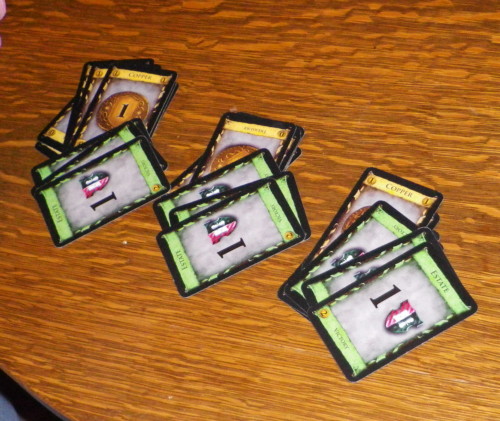
Deal every player a hand of three Estates and seven Copper. The first player is picked randomly (use your favorite method of determining randomness) and for all subsequent games the person to the left of the previous winner goes first. Or you can simply rotate the deal if you aren’t playing tournament style. Play proceeds in a clockwise fashion.
Play: Play is broken down into three phases: Action, Buy, and Clean-up.
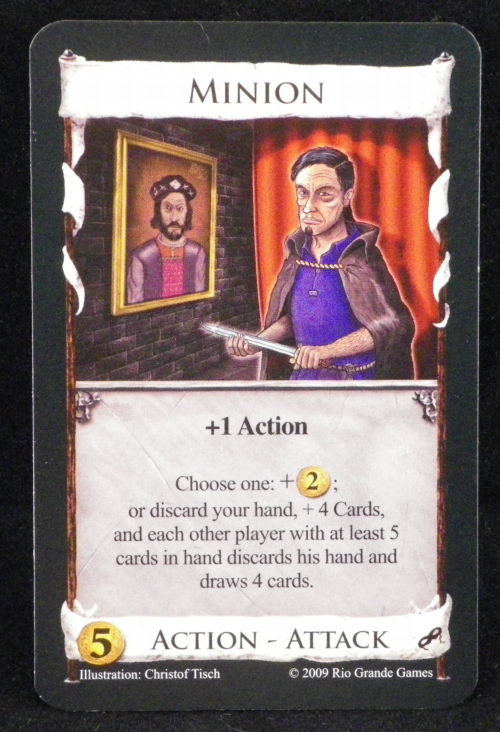
On your Action Phase, you are allowed to take one action, which consists of playing a card that has an action associated with it. The text of the cards will tell you what the action is (draw a card, steal a card, gain a victory point, trash a card, etc.) and in some cases the action might be to take another action. Which you can then take. Minion‘s action is to give you another action Plus when you play Minion you choose to gain 2 monies OR discard your whole hand and draw 4 cards (and everyone else who has at least 5 cards does the same).
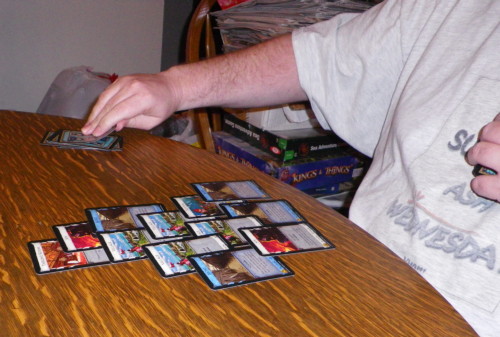
And if it is in the cards, you can keep taking Actions as long as you have actions to take. Kevin is the king of chaining actions as you can see here.
If your cards do not say they do anything (for example, everyone’s first hand will consist of Copper or a mix of Copper and Estates, neither of which carry an action) then…
The Buy Phase is when you can buy cards from the Supply area if you have enough treasure in your hand to do so. Everyone gets one Buy per turn plus any extra Buys that might have been generated by cards played in the Action phase.
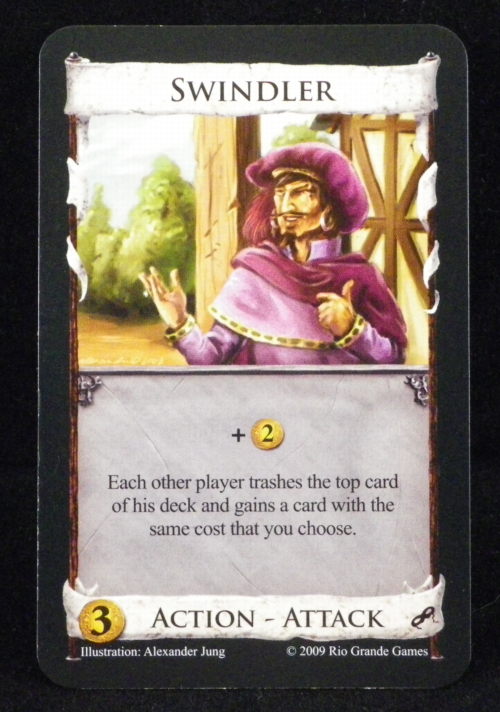
The cost of a card is the number in the lower left hand corner. So Swindler costs 3 monies to purchase from the Supply. Notice the text of this card which says +2 Each other player trashes the top card of his deck and gains a card with the same cost that you choose. This means that if you had played this card on your Action phase, you will generate 2 monies to use in your Buy phase plus everyone else had to trash a card and you picked another to take its place. Generated monies plus whatever Copper, Silver or Gold (or Platinum if you are playing with Prosperity) Treasure cards you have in your hand is the total amount of money you have for buying cards in the Buy phase. If you have a hand that generates no money, remember that Copper (and Curses) cost nothing to buy.
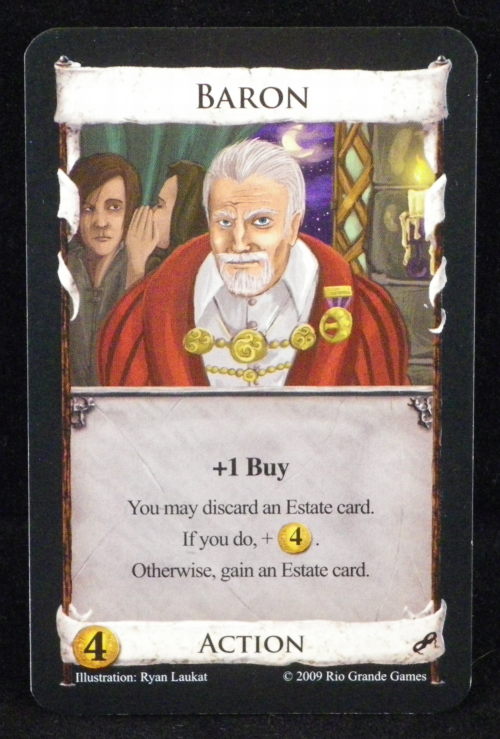
If you played Baron on your Action phase, you will have two total buys this turn: One for your Buy phase and one from the card. Again, if you have more buys than you have monies to use, Coppers (and Curses) cost nothing to buy.
The Clean-up Phase is the phase when you tidy up your own play area by discarding your hand and any cards you’ve acquired onto your discard pile. Some expansions have cards that do certain things during the Clean-up phase; they will note this in the text. Draw five cards in anticipation of the next turn. If you do not have five cards to draw, draw what you can and then shuffle your discard pile and re-purpose it as your draw pile. Draw the remaining cards you need to have a hand of five cards.
There is no right way to set up your draw pile, play area and discard pile but you will want to have some sort of system to keep things from getting confusing. In the example game, we discovered that each of us sets up our play area differently: I usually have my draw pile on the right, a blank area in front for play and my discard to the left. Amy has her draw and discard piles switched and Kevin likes to put his draw and discard next to each other off to one side.
As the game progresses, the deck of cards you cycle through to play (Draw pile – hand – discard and back) will grow. Part of the strategy of the game is to find the perfect balance of how many Treasure cards you have in that deck versus how many Kingdom cards you have to play Actions with and how many Victory cards you have to win. The balance will shift throughout the game as well.
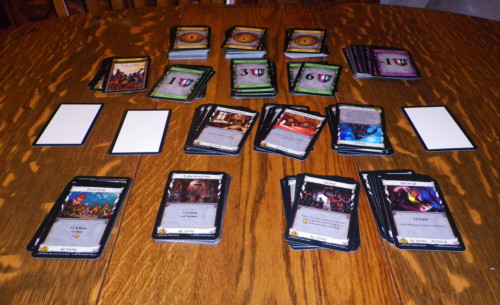
The game ends when three of the piles in the Supply area are depleted (marked by the white cards when the last card of the pile is purchased) OR the Province pile is depleted. When the card is purchased that ends the game and that player has taken their turn, all the players count up their victory points. Curses are a minus victory point and some of the Kingdom cards will generate victory points based on how many of another card you have in your deck. There are also expansions that generate victory tokens; count your tokens as well. Whoever has the most victory points is the winner.
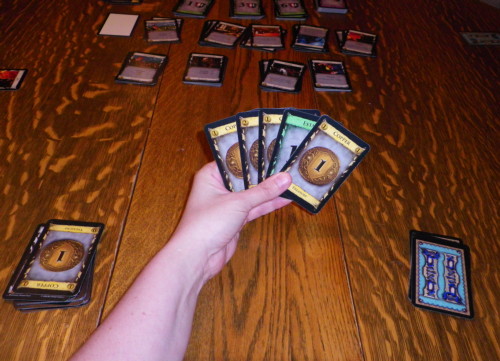
In Media Res 5 Monies! More importantly this is a shot of my playing field with my draw pile to the right and my discard to the left. Notice the stack of cards I have acquired; it never fails that despite the odds of drawing a “beginning hand” (all Treasure and Victory – no actions) becoming progressively smaller and smaller as you add more cards, I somehow manage to draw one or two right about mid game. At least I got a Silver in there.
Would you recommend this game?: I really love this game so I would absolutely recommend it to anyone and everyone. Given that you pick 10 of the 25 available cards for your Kingdom card sets, even if you were limited to just Dominion or Intrigue it would feel like a different game more often than not. The cards interact with each other in slightly different ways so if you chose a similar set of 10 Kingdom cards but switch out one or two, that slight change could significantly alter the style of play. Add in another expansion — or two or all of them — and there are practically an infinite number of variants of the game.
The cards are all marked with expansion symbols so it’s easy to reintegrate them to their parent sets if you choose to play with several different expansions.
My one quibble is that there is not an official master carrying case for all the expansions (not saying I have *all* of them…yet) so it gets really bulky to lug the boxes hither and yon.
Example cards from various sets:
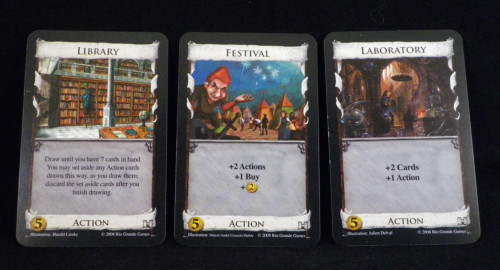
These are from the Dominion base set, they have a little castle in the corner to identify them.
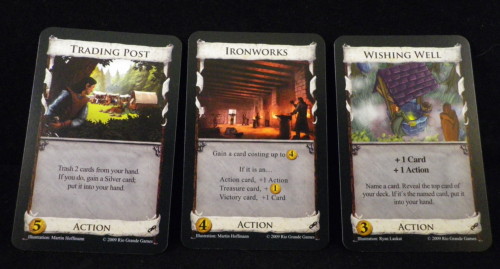
These are cards from the other base set; Intrigue. They have a little mask in the corner.
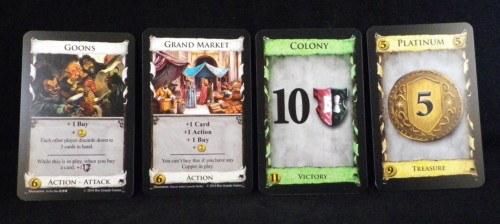
Here are cards from Prosperity. Prosperity adds Colony cards to the Victory set and Platinum cards to the treasure set. Most of the Prosperity cards cost a lot more to purchase as well. Prosperity’s symbol is a small treasure chest.
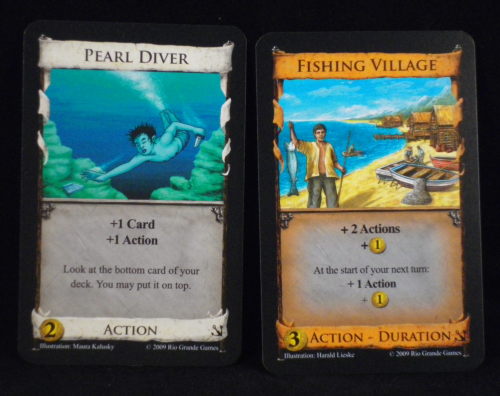
Seaside cards introduce the orange Duration cards which are the cards that do things during the Clean-up phase. Seaside is marked in the corner with an anchor.
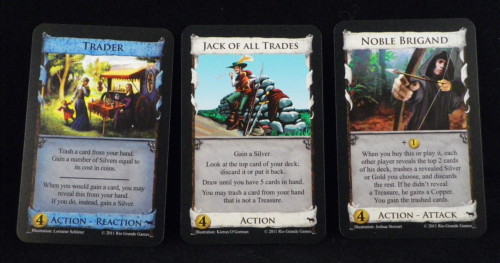
Hinterlands with its pony marker in the corner.
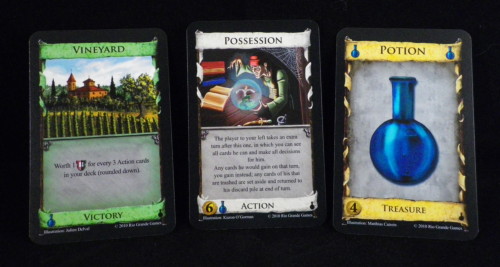
Alchemy introduces a different form of currency (Treasure): The potion. Thus, Alchemy’s symbol is a little bottle.
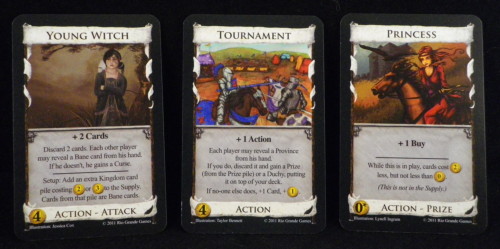
Finally Cornucopia. In Cornucopia there are cards that, if certain parameters are met, let you draw from a Prize stash that is not part of the Supply cards (Princess is a Prize card). The symbol for the Cornucopia set is a feather.
-JQuirk


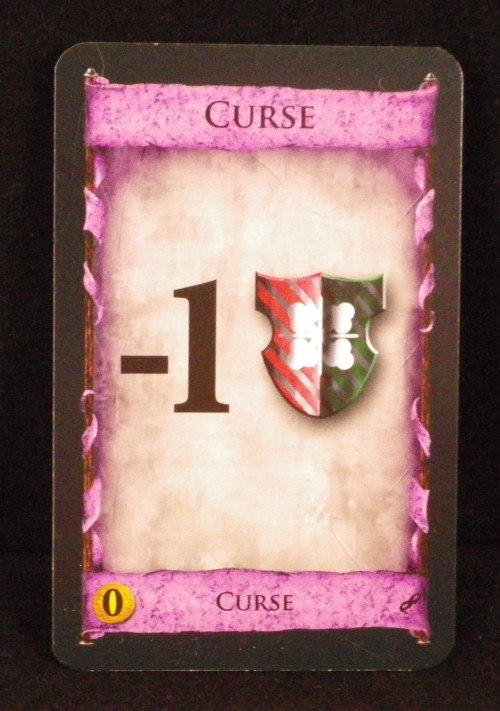
Testing
A new expansion was recently released: Dark Ages.
http://www.amazon.com/Rio-Grande-Games-481RIO-Expansion/dp/B008GRI010/ref=pd_sim_t_6
I categorize it as kind of the “anti-Prosperity.” Its focus seems to be on deck pollution (inflicting of weak cards to dilute your opponents’ effectiveness) and on the Trash (which kind of gets a revolving door with certain Kingdom cards).
“Crazy Spoonhead”, don’t forget the Hinterlands expansion as well! The theme is cards that do something not just when you play them, but at the moment that you buy or gain them to begin with. A subtheme of that set is discarding.
Hmmm…my copies of Dominion, Intrigue, and the earlier expansions recommend the game for age 8 and up. I see that Dark Ages says 13+; I guess they changed it at some point. I don’t know why–Dominion has such simple rules that an 8-year-old could definitely follow them, and none of the cards have really objectionable names or graphics. Younger players probably won’t develop a good strategy or win, but they can certainly play. (My friend’s 8 to 9-year-old can play 10-12 rated games, such as Bohnanza and the Back to the Future card game, just fine. That said, he sometimes loses interest in the official goal and starts playing to harass his dad as much as possible.)
I find the play time of 30 minutes from the box a bit optimistic; if players spend a lot of time re-reading the Kingdom cards and mulling over their choices, which they will if you have new players, a game can easily take an hour or more.
The rules support only 2-4 if you only have one of the two core boxes (base game and Intrigue). Intrigue has rules for 5-6 players, if you have both (or, I suppose, one plus a base card box), but I really don’t recommend it. You’ll have a far better experience breaking into two separate games. Bigger games take proportionally longer between turns and make it harder to buy good combos, as you might only get 1-2 of a desired Kingdom card vs. getting 2-3 or more.
As for buying, I recommend starting with the base game (or Intrigue, if you really like attacks) over the base cards + expansion route. The base game especially has a well-rounded set of cards that mixes well with any combination of expansions. You could also try to find the Big Box, which contains the base game, big expansion Prosperity, small expansion Alchemy, and two promo card packs. Also, strongly consider sleeving your cards, as the basic money and victory points cards will get shuffled so many times that the edges will quickly show wear. The game takes “Euro” size sleeves; I find the thinner sleeves in the 100-count packs work well, and you’ll need 5 packs for the base sets, with 2-5 for each expansion depending on card count.